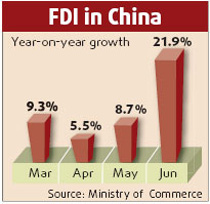China is beefing up its transfer pricing adjustment capability by legislation and policy changes.
Companies are expected to be more proactive on tax planning instead of "playing cat-and-mouse with tax authorities'' under a new enterprise income tax law, industry veterans said.
Legal structure
China has already stepped up action to curb tax avoidance by enterprises, with provisions included in its new enterprise income tax and related implementation rules which took effect this year.
The tax law has a section titled Special Tax Adjustments which covers transfer pricing considerations including advanced pricing agreements and cost sharing arrangements, controlled foreign corporations and general anti-tax avoidance provisions.
But taxpayers will still have to deal with more details which will be published through circulars and notices, a senior official of the tax administration said.
"We are streamlining the laws and rules with more details to be covered in circulars or notices," said He Liantang, anti-avoidance division chief of the international tax department at the State Administration of Taxation, in January in Shanghai.
"Chinese transfer pricing enters a new era with the introduction of the new legal structure," said Luis Coronado, transfer pricing managing partner of Deloitte in Shanghai, "It's much welcomed in China as it pursues to level the playing field."
More attention
Transfer pricing is itself a neutral concept. However, it could be regarded by the tax authorities as a main channel for companies to avoid tax payment by shifting profits to countries with lower tax rates through cross-border related party transactions.
If a multinational company in China is losing money but is expanding its business with frequent cross-border transactions, that firm will be the tax authority's target for auditing.
A bi-yearly global survey made by Ernst & Young found that 67 percent of respondents in China said transfer pricing will be "absolutely critical" to their organizations over the next two years. It's the first time China has been included in the survey.
The respondents in China are primarily subsidiaries of multinationals.
On the other hand, "the laws, rules and coming circulars or requirements help to increase Chinese companies' awareness of the transfer pricing issue especially now that the global economy is increasingly interconnected," said Chi Cheng, a tax partner at Ernst & Young in Shanghai.
In the past, the issue of transfer pricing was not such an issue with some senior management teams of Chinese companies. But with more Chinese companies expanding abroad with increasing cross-border activities, this issue will be something they have to deal with, Chi said.
Be proactive
The Chinese tax authorities are now working on simultaneous documentation requirements for both domestic and cross-border related party transactions to curb tax evasion under the enterprise income tax.
Domestic and foreign-invested legal entities now must file documents with basic details on the nature and volume of the company's cross-border related party transactions.
The forthcoming detailed simultaneous documentation requirements are expected to include specific details such as the taxpayer's organizational structure, nature of business, controlled transactions and applications of the transfer pricing methodology.
The detailed documentation requirements entail that the tax authority will shift the burden of proof to taxpayers, which will save the authorities' resources while companies will be aware of the specifics of transfer pricing issues.
"Companies will be more proactive in transfer pricing issues under a transfer pricing regime in China," said Coronado, an industry veteran for more than a decade.
China will compute interest on a daily basis on the amount of underpaid tax using the central bank's benchmark loan interest rate in yuan, plus an additional five percent penalty.
Given the current rates, the combined rate can be about 12 percent.
"Proactive and timely compliance at an arm's length principle is encouraged, as the five percent penalty can be waived if the taxpayer has prepared satisfactory contemporaneous documentation," said Coronado.
Industry experts expect companies will have to offer documentation when tax authorities ask them to do so, which is different from a previous expectation of an annual submission of the documentation.
"The change signaled that tax authorities will better leverage resources rather than keep a pile of documents which they may not have enough time to go through," Chi said.
Chi said the move is a balance between taxpayer burden and obligation.
Deloitte's Coronado said it's a very smart move for the tax authority to make the shift.
Quality-driven
Though transfer pricing investigation cases have dropped sharply since 2005, the tax adjustment volume that was uncovered increased, indicating the resolve by the Chinese authorities to crack down on transfer pricing violators.
"SAT is more quality-driven than quantity-driven on transfer pricing investigations," said Ernst & Young's Chi.
Before 2005, there were more than 1,500 cases of transfer pricing annually. Since then, the figure has fallen to about 300 cases with tax adjustment topping 460 million yuan. In 2007, there were 192 cases with tax adjustment topping 987 million yuan, SAT figures showed.
(Shanghai Daily February 4, 2008)


